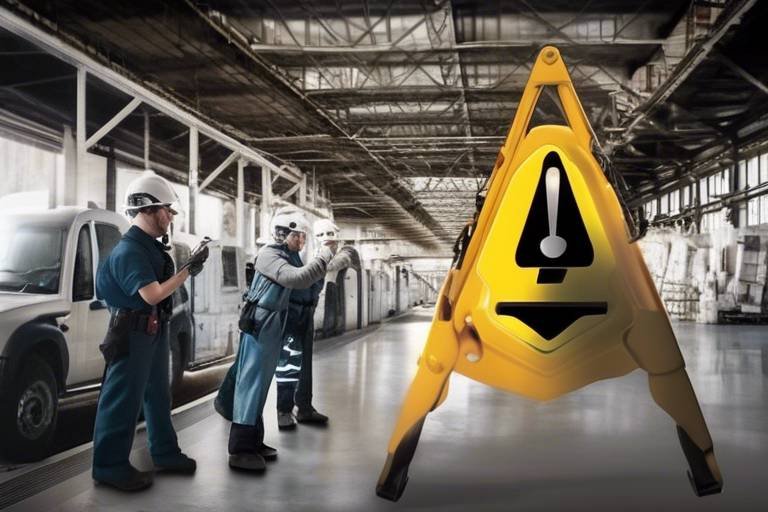Understanding Human Behavior: A Tool for Safety Management
In today's fast-paced work environments, the significance of understanding human behavior in safety management cannot be overstated. It's not just about having the right safety protocols in place; it's about how individuals perceive risks, make decisions, and comply with safety measures. When we delve into the intricacies of human behavior, we uncover a treasure trove of insights that can drastically enhance workplace safety outcomes. So, why is it that some teams thrive in safety while others falter? The answer lies in the psychological factors that influence our actions and reactions.
Imagine a bustling construction site where workers are juggling multiple tasks under tight deadlines. Here, understanding how stress impacts decision-making becomes crucial. If a worker is overwhelmed, their ability to follow safety protocols diminishes, leading to potential accidents. This scenario illustrates the delicate dance between human behavior and safety management. By recognizing the psychological elements at play, organizations can tailor their safety strategies to not only address compliance but also foster a culture of safety awareness.
Furthermore, the role of motivation in safety behavior cannot be ignored. When employees feel valued and motivated, they are more likely to engage in safe practices. It's akin to planting seeds in a garden; with the right care and attention, those seeds grow into a flourishing landscape of safety. Thus, understanding what drives individuals can help organizations create an environment where safety is not just a requirement but a shared value among all team members.
However, embracing the nuances of human behavior in safety management is not without its challenges. Resistance to change often rears its head when new safety protocols are introduced. Employees may be hesitant to alter their routines, especially if they feel their current practices are adequate. Therefore, effective communication and involvement in safety initiatives are paramount to overcoming this resistance.
Ultimately, the journey toward improved safety management through a deeper understanding of human behavior is ongoing. It's about creating a feedback loop where employees feel empowered to share their experiences and insights, leading to continuous improvement in safety practices. As we navigate this complex landscape, one thing remains clear: a proactive approach to understanding human behavior is not just beneficial; it's essential for fostering a safe and healthy workplace.
- Why is understanding human behavior important in safety management?
Understanding human behavior is crucial as it influences decision-making, risk perception, and compliance with safety protocols, ultimately affecting workplace safety outcomes.
- What psychological factors impact safety behavior?
Factors such as stress, fatigue, and motivation can significantly affect individual and team behaviors in safety-critical environments.
- How can organizations improve safety compliance?
By recognizing stressors, implementing support systems, and fostering a culture of safety through motivation and effective training.
- What challenges are faced in understanding human behavior for safety?
Challenges include resistance to change, variability in individual perceptions, and the complexity of human psychology in safety contexts.

The Importance of Human Behavior in Safety Management
Understanding human behavior is not just a nice-to-have in the realm of safety management; it is an absolute necessity. Why, you ask? Because human behavior significantly influences how decisions are made, how risks are perceived, and how well individuals comply with safety protocols. When you think about it, the safety of a workplace hinges not only on the systems and procedures in place but also on the people who operate within those frameworks. If employees do not perceive the importance of safety or understand their role in maintaining it, even the most meticulously crafted safety protocols can fall flat.
Consider this: have you ever ignored a safety guideline because it seemed inconvenient or unnecessary at the moment? This is where the psychology of human behavior comes into play. Factors such as personal beliefs, past experiences, and even peer influence can lead to a disconnect between safety policies and actual practices. In essence, if we want to improve workplace safety outcomes, we must delve into the intricacies of human behavior.
Moreover, the implications of understanding human behavior extend beyond just compliance. By fostering a culture that emphasizes safety, organizations can enhance employee morale and productivity. When employees feel that their safety is a priority, they are more likely to engage positively with safety initiatives. This creates a virtuous cycle where safe practices lead to increased confidence, which in turn encourages even safer behaviors.
To illustrate the significance of human behavior in safety management, let’s look at some key elements:
- Decision-Making: Understanding how individuals make decisions in high-pressure situations can help in designing better safety protocols.
- Risk Perception: Employees' perception of risk can vary dramatically; thus, understanding these perceptions can lead to tailored training programs.
- Compliance: A deep understanding of why people comply or fail to comply with safety measures can inform more effective communication and training strategies.
In conclusion, recognizing the importance of human behavior in safety management is crucial for cultivating a safe workplace. By addressing the psychological factors that influence behavior, organizations can not only improve compliance with safety protocols but also foster a culture that prioritizes safety above all. The journey to a safer workplace begins with understanding the very people who make it all happen.

Psychological Factors Influencing Safety
When it comes to workplace safety, the impact of psychological factors cannot be overstated. These factors, which include stress, fatigue, and motivation, play a pivotal role in shaping how individuals and teams behave in safety-critical environments. Imagine a ship sailing through turbulent waters; the crew's mental state can determine whether the ship navigates safely or capsizes. In the same way, understanding these psychological components is crucial for enhancing safety management practices.
Stress, for instance, can act like a double-edged sword. On one hand, a certain level of stress can motivate employees to perform better; on the other hand, excessive stress can lead to impaired judgment and unsafe behaviors. Think of it as trying to balance on a tightrope; too much pressure can cause a fall. Therefore, recognizing stressors within the workplace—such as tight deadlines, heavy workloads, and interpersonal conflicts—is essential for maintaining a safe environment.
Stress can significantly impair judgment. When individuals are under stress, their ability to make rational decisions diminishes, leading to an increased likelihood of accidents. For example, a worker overwhelmed by deadlines may skip essential safety checks, thinking they can catch up later. This is where implementing support systems becomes vital. By providing resources such as counseling services, flexible work hours, and team-building activities, organizations can help employees manage stress more effectively, ultimately enhancing safety compliance.
Identifying specific stress factors is crucial for developing effective strategies to mitigate their impact on safety behaviors. Some common stressors include:
- Workload and time pressures
- Interpersonal conflicts
- Unclear job expectations
- Inadequate resources
By recognizing these factors, organizations can tailor their approaches to address the unique stressors that their employees face, fostering a safer work environment.
Implementing stress management programs can lead to significant improvements in employee resilience. These programs might include workshops on time management, relaxation techniques, and team support initiatives. When employees feel supported, they are more likely to engage in safe practices. Imagine a garden; when plants receive adequate water and sunlight, they flourish. Similarly, employees who receive proper support are more likely to thrive in their roles and prioritize safety.
Another psychological factor that significantly influences safety is motivation. Understanding what drives employees can enhance their commitment to safety practices. When employees are motivated, they are more likely to engage in proactive behaviors, such as reporting hazards or following safety protocols. This creates a culture of safety where everyone feels accountable for their actions. It’s like a relay race; every runner must pass the baton safely to ensure the team wins. In a workplace, this means that each employee must take responsibility for safety, encouraging others to do the same.
In summary, psychological factors like stress and motivation play a critical role in shaping safety behaviors in the workplace. By understanding these factors and implementing effective strategies to address them, organizations can enhance their safety management practices, creating a safer, more productive work environment.
Q1: How does stress affect workplace safety?
A1: Stress can impair judgment and lead to unsafe behaviors, making it essential to identify and manage stressors to enhance safety compliance.
Q2: What are some common stress factors in the workplace?
A2: Common stress factors include workload pressures, interpersonal conflicts, unclear job expectations, and inadequate resources.
Q3: How can organizations improve employee motivation toward safety practices?
A3: Organizations can improve motivation by recognizing and rewarding safe behaviors, providing training, and fostering a culture of accountability.

The Role of Stress in Safety Compliance
Stress plays a significant role in influencing safety compliance in the workplace. When individuals are under stress, their ability to make sound decisions can be compromised. Imagine trying to navigate a busy street while juggling multiple tasks; the stress can lead to mistakes and unsafe behaviors. This scenario is not too far from what happens in high-pressure work environments where the stakes are high, and the margin for error is slim. Stress can cloud judgment, impair focus, and ultimately lead to unsafe practices that jeopardize not only the individual but also their colleagues and the overall safety of the workplace.
Recognizing the various stressors that employees face is crucial for fostering a culture of safety. Stress can stem from numerous sources, including heavy workloads, tight deadlines, and interpersonal conflicts. For example, a worker who feels overwhelmed by their workload may rush through safety checks, increasing the risk of accidents. To combat this, organizations must identify these stress factors and implement support systems that promote well-being. This could include stress management training, counseling services, or simply encouraging regular breaks to recharge.
Implementing effective stress management programs can lead to significant improvements in safety compliance. These programs not only help employees develop coping strategies but also foster resilience. When employees feel supported and equipped to handle stress, they are more likely to adhere to safety protocols and report unsafe conditions. A well-structured program might include workshops on mindfulness, time management, and relaxation techniques, all aimed at reducing stress levels and enhancing focus on safety.
Moreover, it's essential to create an open dialogue about stress and safety. Encouraging employees to share their experiences and stressors can help management understand the challenges they face. This can lead to tailored solutions that address specific issues, ultimately enhancing safety compliance. For instance, a team meeting where employees can voice their concerns might reveal common stressors that, once addressed, improve overall safety practices.
In conclusion, the relationship between stress and safety compliance is a critical one. By acknowledging the impact of stress on decision-making and behavior, organizations can take proactive steps to mitigate its effects. This not only enhances safety compliance but also contributes to a healthier, more productive work environment. Remember, a safe workplace is not just about rules and regulations; it's also about understanding the human factors that influence safety behaviors.
- What are the main stressors affecting workplace safety?
Common stressors include high workloads, time constraints, lack of support, and interpersonal conflicts among team members.
- How can organizations support employees dealing with stress?
Organizations can implement stress management programs, provide counseling services, and encourage open communication about stressors.
- What are the signs of stress that can impact safety compliance?
Signs include decreased focus, increased errors, irritability, and withdrawal from safety protocols.
- How does stress management improve safety outcomes?
Effective stress management enhances employee resilience and focus, leading to better adherence to safety practices and reduced risk of accidents.

Identifying Stress Factors
Identifying stress factors in the workplace is a crucial step toward enhancing safety management and ensuring employee well-being. Stress can be insidious, often creeping into the work environment unnoticed until it manifests in decreased performance or, worse, unsafe behaviors. To tackle this issue effectively, organizations need to conduct a thorough assessment of potential stressors that employees face on a daily basis. These stressors can be categorized into various domains, including:
- Workload: An excessive workload can lead to feelings of being overwhelmed, which can impair judgment and decision-making.
- Time Pressures: Tight deadlines can create a sense of urgency that may compromise safety protocols as employees rush to complete tasks.
- Interpersonal Conflicts: Tensions with colleagues or management can create a toxic atmosphere, leading to distractions and reduced focus on safety.
- Job Security: Uncertainty about job stability can lead to anxiety, affecting concentration and overall performance.
By recognizing these categories, companies can begin to pinpoint specific stress factors affecting their workforce. For instance, a team working under constant pressure to meet deadlines may experience heightened anxiety, which can lead to hasty decisions that jeopardize safety. Similarly, employees who feel insecure in their roles might prioritize job survival over adhering to safety protocols. Thus, understanding the nuances of stressors is imperative.
Moreover, organizations can employ various methods to identify these stress factors, such as:
- Employee Surveys: Regularly conducting anonymous surveys allows employees to voice their concerns and identify stressors they face.
- Focus Groups: Organizing focus groups can facilitate open discussions, enabling employees to share their experiences and insights.
- Observation: Managers should observe employees in their natural work environment to identify behaviors that may indicate stress.
Once stress factors are identified, the next step is to develop targeted strategies to mitigate them. This proactive approach not only enhances safety compliance but also fosters a healthier, more productive work environment. By prioritizing the identification and management of stress factors, organizations can ensure that their employees are not just compliant with safety protocols but are genuinely engaged in creating a culture of safety.
Q: Why is it important to identify stress factors in the workplace?
A: Identifying stress factors is crucial as it helps organizations understand the root causes of unsafe behaviors and enhances overall workplace safety and employee well-being.
Q: How can organizations effectively identify these stress factors?
A: Organizations can use employee surveys, focus groups, and observational methods to gather insights on potential stressors affecting their workforce.
Q: What are some common stress factors in the workplace?
A: Common stress factors include excessive workload, time pressures, interpersonal conflicts, and job security concerns.
Q: How can addressing stress factors improve safety compliance?
A: By reducing stress, employees can make clearer decisions, focus better on their tasks, and adhere more strictly to safety protocols, leading to a safer work environment.

Implementing Stress Management Programs
Implementing stress management programs in the workplace is not just a trend; it's a necessity for fostering a safe and productive environment. These programs are designed to help employees recognize their stressors and develop coping strategies that can significantly enhance their well-being and safety compliance. By addressing stress proactively, organizations can create a culture where employees feel supported and valued, which in turn promotes safer behaviors.
One of the first steps in implementing such programs is to conduct a thorough assessment of stressors within the workplace. This can involve surveys, interviews, and focus groups that allow employees to voice their concerns and experiences. Understanding what causes stress—be it workload, interpersonal conflicts, or external pressures—enables management to tailor programs that address these specific issues. For instance, if a significant number of employees report feeling overwhelmed by deadlines, the organization might consider revising project timelines or redistributing workloads.
Next, organizations should consider offering a variety of stress management techniques that employees can choose from. These may include workshops on mindfulness, relaxation techniques, and time management skills. Incorporating physical activities, such as yoga or team sports, can also be beneficial. These activities not only provide a break from work but also foster camaraderie among employees, which can alleviate stress. Here are some popular methods:
- Mindfulness Training: Helps employees focus on the present moment, reducing anxiety about future tasks.
- Time Management Workshops: Teaches employees how to prioritize tasks effectively.
- Physical Activities: Encourages exercise, which is proven to reduce stress levels.
Moreover, creating an environment that encourages open communication about stress is essential. Employees should feel comfortable discussing their stressors without fear of judgment. This can be achieved by establishing regular check-ins, where managers can gauge employee well-being and offer support. Additionally, providing resources such as access to counseling services or employee assistance programs (EAPs) can further enhance the effectiveness of stress management initiatives.
Finally, it’s crucial to evaluate the effectiveness of these programs continuously. Organizations should track participation rates, gather feedback from employees, and monitor any changes in workplace safety metrics. This data can provide insights into what works and what doesn’t, allowing for adjustments that will make the programs even more effective. Remember, the goal is not just to reduce stress but to create a sustainable culture of safety and support that empowers employees to prioritize their mental health while performing their duties.
Q1: What are the key benefits of implementing stress management programs?
A1: Stress management programs can lead to improved employee well-being, enhanced safety compliance, reduced absenteeism, and increased productivity.
Q2: How can I identify stressors in my workplace?
A2: Conduct surveys, hold focus groups, and encourage open discussions to gather insights from employees about their stressors.
Q3: What types of activities are included in stress management programs?
A3: Activities can range from mindfulness training and relaxation techniques to physical exercises and time management workshops.
Q4: How can I measure the effectiveness of a stress management program?
A4: Track participation rates, gather employee feedback, and monitor changes in safety metrics and overall workplace morale.

Motivation and Safety Behavior
Understanding what drives employees is crucial for enhancing safety practices in the workplace. Motivation plays a pivotal role in shaping safety behavior, as it directly influences how committed individuals are to following safety protocols. When employees feel motivated, they are more likely to engage in safe practices, report hazards, and participate in safety training. It's almost like a ripple effect; when one person feels motivated, it can inspire others around them to adopt similar attitudes toward safety.
So, what exactly motivates employees to prioritize safety? There are several factors at play:
- Intrinsic Motivation: This comes from within. Employees who find personal satisfaction in doing their jobs safely are likely to take ownership of their actions.
- Extrinsic Motivation: This includes external rewards such as bonuses, recognition, or promotions for adhering to safety practices. When employees see tangible benefits, they are more inclined to follow safety protocols.
- Peer Influence: A strong safety culture encourages employees to motivate each other. When team members support one another, it creates an environment where safety becomes a collective responsibility.
Creating a culture that fosters motivation requires a proactive approach. Employers can implement various strategies to enhance motivation related to safety:
- Open Communication: Encourage employees to voice their concerns and suggestions regarding safety practices. When employees feel heard, they are more likely to engage actively in safety initiatives.
- Recognition Programs: Establish programs that reward safe behavior. Recognizing employees for their commitment to safety not only boosts morale but also reinforces the importance of safety in the workplace.
- Continuous Feedback: Providing regular feedback helps employees understand the impact of their actions on safety. Constructive feedback can motivate employees to improve their safety behavior.
Moreover, when organizations prioritize employee well-being, motivation naturally increases. A healthy work environment reduces stress and enhances job satisfaction, which translates into better safety practices. Just think about it—when employees feel valued and supported, they are more likely to go the extra mile to ensure their own safety and that of their colleagues.
In summary, understanding the link between motivation and safety behavior is essential for creating a robust safety culture. By fostering an environment that motivates employees, organizations can significantly improve compliance with safety protocols and reduce risks. After all, a motivated workforce is not just an asset; it's a vital component of a safe and productive workplace.
Q1: How can I improve employee motivation for safety?
A1: Improving motivation can be achieved through open communication, recognition programs, and continuous feedback. Creating a supportive environment where employees feel valued is key.
Q2: What role does peer influence play in safety behavior?
A2: Peer influence is significant; when employees encourage each other to prioritize safety, it fosters a culture of collective responsibility, enhancing overall safety practices.
Q3: Are intrinsic or extrinsic motivators more effective for safety?
A3: Both intrinsic and extrinsic motivators are important. While intrinsic motivation leads to personal satisfaction, extrinsic rewards can provide tangible incentives for safe behavior.

Training and Development for Safety Awareness
In today's fast-paced work environment, effective training programs are paramount for enhancing safety awareness among employees. These programs are not just about following rules; they are about instilling a sense of responsibility and commitment to safety practices. When employees understand the significance of their actions and how they contribute to a safer workplace, they become proactive in identifying and mitigating risks. Imagine a workplace where every employee feels empowered to speak up about safety concerns! This is the culture we strive to create through comprehensive training and development.
One of the most impactful methods for fostering safety awareness is through behavior-based safety training. This approach emphasizes the importance of observational skills and feedback mechanisms. Employees are trained to recognize unsafe behaviors not just in themselves but also in their peers. By cultivating a culture of observation, workers can engage in constructive conversations about safety practices. For instance, if one team member notices another bypassing a safety protocol, they are encouraged to address it directly, fostering a supportive environment that prioritizes safety above all.
Moreover, we must consider the role of continuous learning and adaptation in safety training. The workplace is not static; new challenges and risks emerge regularly. Therefore, safety training should evolve to meet these changes. Regular refresher courses and updates on the latest safety protocols ensure that employees remain aware of evolving risks and best practices. Think of it like a sports team that practices year-round! Just as athletes continuously refine their skills to stay competitive, employees must also adapt their safety practices to ensure they are equipped to handle new challenges.
To illustrate the effectiveness of training programs, consider the following table that outlines the key components of a successful safety training initiative:
| Component | Description |
|---|---|
| Needs Assessment | Evaluate the specific safety training needs of employees based on their roles and previous incidents. |
| Interactive Training Modules | Utilize engaging and interactive content to maintain employee interest and enhance learning retention. |
| Real-Life Scenarios | Incorporate real-world examples and scenarios to help employees relate to safety protocols. |
| Feedback Mechanisms | Establish systems for employees to provide feedback on training effectiveness and suggest improvements. |
| Regular Reviews | Conduct regular reviews of training content to ensure it remains relevant and effective. |
In conclusion, is not just a checkbox on a compliance list; it is a vital investment in the well-being of employees and the organization as a whole. By prioritizing effective training programs, companies can foster a culture of safety that not only reduces accidents but also enhances employee morale and productivity. After all, when employees feel safe and valued, they are more likely to contribute positively to the workplace.
- What is behavior-based safety training?
Behavior-based safety training focuses on changing employees' behaviors to improve safety outcomes. It emphasizes observation and feedback to encourage safe practices.
- How often should safety training be conducted?
Safety training should be conducted regularly, with refresher courses at least annually or whenever new risks or protocols emerge.
- What are the benefits of continuous learning in safety?
Continuous learning helps employees stay updated on best practices, enhances their ability to identify risks, and fosters a culture of accountability and safety.

Behavior-Based Safety Training
Behavior-based safety training is a dynamic approach that focuses on the actions and attitudes of employees as they relate to safety in the workplace. Unlike traditional safety training, which often emphasizes rules and regulations, this method dives deeper into understanding the why behind unsafe behaviors. By fostering an environment where employees can openly discuss their safety practices, organizations can identify patterns and pinpoint areas that require improvement. This approach not only enhances safety compliance but also builds a sense of community among team members.
At its core, behavior-based safety training revolves around the idea that safety is not just about following protocols; it's about cultivating a culture of accountability. When employees feel responsible for their own safety and that of their peers, they are more likely to engage in positive safety behaviors. This training encourages employees to observe one another, providing constructive feedback that reinforces safe practices. For example, if one team member notices another bypassing a safety procedure, they can address it in a supportive manner, fostering a team-oriented approach to safety.
To implement an effective behavior-based safety training program, organizations should consider the following key components:
- Observation Skills: Employees are trained to recognize both safe and unsafe behaviors in themselves and others. This awareness is crucial for preventing accidents.
- Feedback Mechanisms: Establishing a system where employees can give and receive feedback promotes a culture of continuous improvement.
- Positive Reinforcement: Recognizing and rewarding safe behaviors can motivate employees to maintain high safety standards.
Moreover, behavior-based safety training is not a one-time event; it requires ongoing commitment. Regular refresher courses and workshops help keep safety at the forefront of employees' minds. By continuously engaging with the principles of behavior-based safety, organizations can adapt to new challenges and foster a resilient workforce.
In conclusion, behavior-based safety training is a powerful tool that not only enhances safety compliance but also empowers employees. By focusing on the behaviors that lead to safety incidents, organizations can create a proactive safety culture where everyone plays a role in maintaining a safe work environment.
Q1: What is behavior-based safety training?
A1: Behavior-based safety training focuses on understanding and modifying employee behaviors related to safety, emphasizing observation and feedback to promote safe practices.
Q2: How does behavior-based safety training differ from traditional safety training?
A2: Unlike traditional training that primarily focuses on rules and regulations, behavior-based safety training encourages employees to engage with one another about their safety practices, fostering a culture of accountability.
Q3: What are the benefits of implementing behavior-based safety training?
A3: The benefits include improved safety compliance, a stronger safety culture, increased employee engagement, and reduced workplace accidents.
Q4: How can organizations ensure the effectiveness of behavior-based safety training?
A4: Organizations can ensure effectiveness by providing ongoing training, establishing feedback mechanisms, and recognizing safe behaviors to maintain motivation among employees.

Continuous Learning and Adaptation
In today's fast-paced world, the concept of continuous learning and adaptation is not just a buzzword; it's a necessity, especially in the realm of safety management. Organizations must recognize that the environment in which they operate is constantly evolving, and so are the risks associated with it. Just like a ship navigates through changing tides, businesses must be prepared to adjust their safety protocols and training programs to keep up with new challenges and technologies.
One of the most effective ways to foster a culture of continuous learning is through ongoing training sessions that are designed to be interactive and engaging. Traditional training methods can often feel stale and uninspiring, leading to disengagement among employees. Instead, incorporating real-world scenarios and hands-on activities can make learning more relevant and impactful. For instance, simulation-based training allows employees to practice their skills in a safe environment, enhancing their ability to respond to actual safety hazards.
Moreover, organizations should encourage a feedback-rich environment where employees feel comfortable sharing their experiences and insights. This not only promotes a sense of ownership but also helps in identifying areas that require improvement. Regularly scheduled meetings or workshops can serve as platforms for discussing safety concerns and brainstorming solutions. By doing so, companies can create a dynamic learning atmosphere where everyone is invested in safety outcomes.
Another crucial aspect of continuous learning is the integration of technology. With advancements in digital tools and platforms, organizations can leverage e-learning modules and mobile applications to provide employees with easy access to safety information and training resources. This flexibility allows workers to learn at their own pace and revisit materials as needed, ensuring that they remain well-informed about the latest safety practices.
To illustrate the importance of continuous learning in safety management, consider the following table that outlines key benefits:
| Benefit | Description |
|---|---|
| Enhanced Awareness | Employees stay updated on new safety protocols and practices. |
| Improved Compliance | Regular training reinforces adherence to safety regulations. |
| Increased Engagement | Interactive learning fosters a culture of participation and investment in safety. |
| Adaptability | Organizations can quickly adjust to new risks and challenges. |
In conclusion, the journey of continuous learning and adaptation is vital for enhancing safety management practices. By investing in effective training, leveraging technology, and fostering open communication, organizations can create a robust safety culture that not only protects employees but also drives overall success. Remember, safety isn't just a one-time effort; it's an ongoing commitment to learning and improving.
- Why is continuous learning important in safety management? Continuous learning ensures that employees are always updated on the latest safety practices and can adapt to new risks effectively.
- How can organizations promote a culture of safety? By providing ongoing training, encouraging feedback, and utilizing technology to make learning accessible and engaging.
- What role does technology play in safety training? Technology offers flexible and interactive training solutions, allowing employees to learn at their own pace and revisit materials as necessary.

Challenges in Understanding Human Behavior
Understanding human behavior in the context of safety management is no walk in the park. It’s like trying to solve a complex puzzle where each piece represents a different aspect of human psychology. One of the most significant challenges is resistance to change. When organizations introduce new safety protocols or changes in procedures, employees might feel uncomfortable or skeptical. This resistance can stem from a variety of sources, such as fear of the unknown, past experiences with ineffective changes, or simply a preference for the status quo. To tackle this, effective communication is essential. Engaging employees in discussions about the benefits of changes can help ease their concerns and foster a sense of ownership in the process.
Another hurdle is the variability in individual perceptions. Each person brings their own set of experiences, beliefs, and values to the workplace. This diversity can lead to differing interpretations of safety measures and protocols. For instance, while one employee might see a particular safety procedure as necessary, another might view it as an unnecessary burden. This inconsistency complicates the implementation of uniform safety measures. Organizations need to recognize these differences and strive to accommodate them. Tailoring safety training and communication to address individual concerns can significantly enhance overall compliance.
Moreover, the complexity of human psychology itself adds another layer of difficulty. People are influenced by a myriad of factors, including their emotional state, social environment, and even their physical health. For example, stress and fatigue can cloud judgment, leading to unsafe behaviors. A person who is overwhelmed with work may overlook safety protocols, believing they are too busy to follow them. This interconnectedness of psychological factors makes it crucial for safety management strategies to be holistic. Organizations should consider implementing comprehensive assessment tools that evaluate not just the physical environment but also the psychological well-being of employees.
To summarize, the challenges in understanding human behavior in safety management are multifaceted and require a nuanced approach. Here’s a quick overview of these challenges:
| Challenge | Description |
|---|---|
| Resistance to Change | Employees may be hesitant to adopt new safety protocols due to fear or discomfort. |
| Variability in Individual Perceptions | Diverse backgrounds lead to different interpretations of safety measures. |
| Complexity of Human Psychology | Emotional and physical factors can influence safety behaviors significantly. |
Ultimately, addressing these challenges requires a commitment to understanding the human element in safety management. By fostering open communication, recognizing individual differences, and considering psychological factors, organizations can create a safer and more supportive work environment. After all, safety is not just about rules and regulations; it’s about people.
- What are the main psychological factors that affect safety behavior? Factors such as stress, fatigue, and motivation play crucial roles in influencing how individuals behave in safety-critical situations.
- How can organizations reduce resistance to change? Effective communication and employee involvement in safety initiatives can help reduce resistance and foster acceptance of new protocols.
- Why is it important to consider individual perceptions in safety management? Recognizing individual differences allows for tailored safety measures that can lead to better compliance and a stronger safety culture.

Resistance to Change
Resistance to change is a significant hurdle in the realm of safety management, where the stakes are often incredibly high. When organizations attempt to implement new safety protocols or modify existing ones, they can encounter pushback from employees who are comfortable with the status quo. This resistance can stem from various sources, including fear of the unknown, skepticism about the effectiveness of new measures, or a simple preference for familiar routines. Imagine trying to steer a massive ship in a new direction; it takes time, effort, and, most importantly, the cooperation of the crew. Without their buy-in, even the best-laid plans can falter.
To effectively navigate this resistance, it’s crucial to foster a culture of open communication. Employees need to feel that their voices are heard and that they play a role in the change process. This can be achieved through:
- Regular feedback sessions where employees can express their concerns and suggestions.
- Transparent discussions about the reasons behind the changes and the expected benefits.
- Involvement of employees in the planning and implementation stages of new safety measures.
Moreover, training programs should not only focus on the new protocols but also address the emotional and psychological aspects of change. For example, workshops that help employees understand the importance of adaptability and resilience can be incredibly beneficial. When employees see that change is not just a mandate but an opportunity for growth, they are more likely to embrace it.
Another critical component in overcoming resistance is leadership. Leaders must model the behaviors they wish to see and demonstrate their commitment to safety initiatives. When employees observe their leaders actively participating in training and adhering to new protocols, it sends a powerful message that change is not only necessary but also valued. This alignment can significantly reduce resistance and foster a more cohesive approach to safety management.
In conclusion, while resistance to change is a common challenge in safety management, it is not insurmountable. By prioritizing communication, involvement, and strong leadership, organizations can create an environment where change is seen as a positive step toward a safer workplace. After all, embracing change is akin to evolving in a dynamic environment; it’s not just about survival but thriving in the face of challenges.
Q: Why do employees resist change in safety protocols?
A: Employees often resist change due to fear of the unknown, skepticism about new measures, or a preference for their established routines. Addressing these concerns through open communication can help mitigate resistance.
Q: How can organizations effectively communicate changes in safety protocols?
A: Organizations can communicate changes effectively by holding regular feedback sessions, discussing the reasons behind the changes, and involving employees in the planning process. Transparency is key.
Q: What role does leadership play in overcoming resistance to change?
A: Leadership plays a crucial role by modeling desired behaviors, actively participating in training, and demonstrating commitment to new safety measures, which can inspire employees to embrace change.
Q: Are training programs necessary for managing resistance to change?
A: Yes, training programs that address both the technical aspects of new protocols and the emotional aspects of change can significantly help employees adapt and reduce resistance.

Variability in Individual Perceptions
When it comes to safety management, one of the most intriguing yet challenging aspects is the . Each employee brings their own unique experiences, backgrounds, and beliefs to the workplace, which can significantly influence how they interpret safety protocols and potential risks. Imagine a group of people standing at the edge of a cliff; some might see the breathtaking view, while others are fixated on the danger of falling. This metaphor highlights how perceptions can vary drastically, even in the same situation.
This variability can stem from several factors, including personal experiences, cultural backgrounds, and even individual psychological traits. For instance, an employee who has previously experienced a workplace accident may perceive risks more acutely than someone who has never faced such a situation. Similarly, cultural attitudes towards safety can shape how individuals respond to safety training and protocols. In some cultures, a more hierarchical approach may lead to compliance out of respect for authority, while in others, open dialogue and personal responsibility may be more emphasized.
Moreover, psychological traits such as risk tolerance play a crucial role. Some individuals are naturally more cautious, while others might be more inclined to take risks. This difference can lead to varied responses to safety measures. For example, a person with a high risk tolerance might disregard safety equipment, believing they can navigate hazards without it, whereas a more cautious individual would adhere strictly to safety guidelines.
To effectively manage these differences, organizations must adopt a tailored approach to safety training and communication. This could involve:
- Conducting Surveys: Gathering data on employee perceptions can help identify common misconceptions and areas of concern.
- Personalized Training: Offering training sessions that cater to different perception levels can enhance understanding and compliance.
- Encouraging Open Dialogue: Creating a culture where employees feel safe to express their views can lead to a better understanding of varying perceptions.
In conclusion, recognizing and accommodating the variability in individual perceptions is not just a nice-to-have; it’s a necessity for fostering a robust safety culture. By understanding that each employee's viewpoint can shape their behavior and compliance, organizations can implement more effective safety strategies that resonate with their workforce.
- Why is understanding individual perceptions important in safety management?
Understanding individual perceptions helps identify potential gaps in safety compliance and enhances the effectiveness of safety training programs. - How can organizations address variability in perceptions?
Organizations can address variability by conducting surveys, offering personalized training, and encouraging open communication among employees. - What role does culture play in safety perceptions?
Cultural backgrounds can significantly influence how individuals view risks and safety protocols, impacting their compliance and behavior in the workplace.
Frequently Asked Questions
- Why is understanding human behavior crucial in safety management?
Understanding human behavior is vital because it directly influences how individuals make decisions, perceive risks, and comply with safety protocols. When we grasp the psychological elements that drive behavior, we can create more effective safety management practices that lead to improved workplace outcomes.
- What psychological factors affect workplace safety?
Several psychological factors play a significant role in workplace safety, including stress, fatigue, and motivation. For instance, high stress levels can impair judgment, leading to unsafe behaviors, while motivation can enhance an employee's commitment to following safety practices.
- How does stress impact safety compliance?
Stress can cloud judgment and lead to poor decision-making, which often results in unsafe behaviors. By identifying stressors and implementing support systems, organizations can enhance safety compliance and improve overall employee well-being.
- What strategies can be used to manage stress in the workplace?
Implementing stress management programs is key. These programs can include mindfulness training, workload adjustments, and creating a supportive work environment. Such initiatives help employees build resilience and can lead to better safety outcomes.
- How does motivation influence safety behavior?
Motivation is a powerful driver of behavior. When employees are motivated to prioritize safety, they are more likely to engage in proactive risk management and adhere to safety protocols, fostering a culture of safety within the organization.
- What role does training play in enhancing safety awareness?
Training is essential for equipping employees with the skills needed to recognize and respond to safety hazards. Effective training programs focused on human behavior can promote a proactive safety culture and empower employees to take ownership of their safety practices.
- What challenges exist in understanding human behavior in safety contexts?
Challenges include resistance to change, variability in individual perceptions, and the complexity of human psychology. Addressing these challenges requires effective communication and a tailored approach to safety management that acknowledges individual differences.
- How can organizations overcome resistance to change in safety initiatives?
Overcoming resistance involves engaging employees in the safety process, providing clear communication about the benefits of changes, and ensuring their voices are heard in safety initiatives. This fosters a sense of ownership and acceptance among the workforce.



















